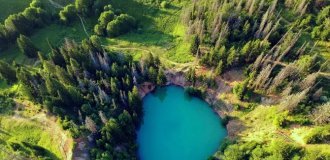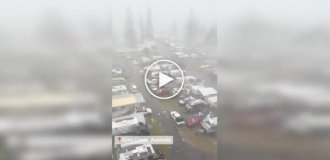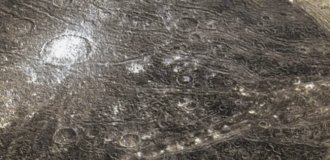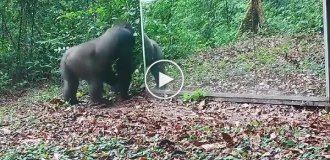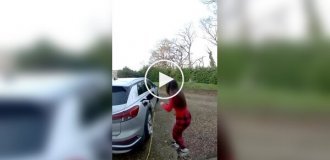Return to 1986 (79 photos)

This was probably my most unusual, most extreme from the point of view of a common man in the street, and at the same time the most interesting trip in my entire relatively short life. It was also quite difficult and instructive, because... I had to see the full scale of the tragedy that once shook the whole world and, in particular, directly affected and radically changed the fate of thousands of people, many of whom have long been dead.
They say that traveling to those places and seeing there greatly changes a person. I can’t say that this trip changed me that much, but I made certain serious conclusions in my life, and invaluable experience was added to my piggy bank, which a rare person can boast of. Of course, all impressions and emotions cannot be expressed in words and journal entries. You definitely need to see it for yourself, touch it live. This is a lesson, an experience, and new feelings. You only need to go with an understanding of where you are going and why. Otherwise you shouldn't do this at all.
But for those who have never been there and do not intend to be there, or have not heard anything about it and do not know anything, I will still slightly lift the veil of secrecy over that place, which, on the one hand, repels with its horror and the tragedy of the events that happened in it, but on the other hand, at the same time it attracts with its mystery and aesthetics... This is the place about which legends are formed and about which all sorts of rumors and myths circulate... This is the place where I was...
On April 26, 1986, at approximately 1:23:50, an explosion occurred at the 4th power unit of the Chernobyl Nuclear Power Plant (ChNPP), located on the territory of Ukraine (at that time - the Ukrainian SSR), which completely changed the history of mankind. I will not describe in detail the entire history of that terrible accident, so if anyone is interested, detailed information about the history of the Chernobyl disaster, the technical characteristics of the plant and the consequences of the accident can be found on the official website of the Chernobyl nuclear power plant - https://www.chnpp.atom.gov.ua . And also on Wikipedia.
At the beginning, I would like to debunk some of the most common myths about the Chernobyl exclusion zone. As Churchill said: “Who owns the information, owns the world!” So, most of the prejudices regarding the Chernobyl exclusion zone are precisely that same ignorance, lack of possession of truthful information.
Myth 1. There is radiation there!!! How can you go there?!
It can be done quite calmly. The consequences of the disaster led to a misleading stereotype - the idea of the zone as a contaminated land, a nuclear desert, devoid of life and certainly not a place where a normal person would want to go. It is worth noting that most radioactive substances decayed in the first days of infection. The territory of the zone is contaminated with elements that do not create a high gamma background, but are dangerous if they enter the body. Radioactivity has decreased to background levels and in most places does not exceed 19 μR/hour. In an average of two days, a person can receive an additional dose of radiation equal to approximately the dose received during a four-hour plane flight. You just need to follow simple rules, such as:
1) unquestioningly following the instructions of the accompanying person;
2) the correct form of clothing, i.e. maximally closed clothing with long sleeves and completely closed shoes (wearing special clothing is not at all necessary, but the use of glasses and a respirator will undoubtedly increase the safety of being in the area);
3) follow the accompanying person at all times and do not go where they say “You can’t!”;
4) do not eat local food, but take it with you so that it is sealed and does not require direct contact with your hands (it is strongly recommended not to eat or drink outdoors at all);
5) if possible, do not touch any foreign objects, especially those made of metal and even more especially those used in the liquidation of the accident, as well as moss.
When leaving the zone, everyone, without exception, is subject to radiation monitoring, and if their clothes are contaminated, they simply will not be allowed out of the zone wearing them.
Is traveling to the zone dangerous? Draw your own conclusions.
Myth 2. Excursion to Chernobyl? This is blasphemy! You go to have fun where human pain lives, where people died! How can you mock the tragedy of millions like that??! You will be walking on bones!
You know, after reading the lion's share of forums and hearing a similar question from many people I know, I was very surprised at how the question was posed. Firstly, it’s not children who go there, but adults. Everyone knows what happened in Chernobyl in 1986. The 30-kilometer zone around the Chernobyl nuclear power plant is the territory where one of the greatest environmental disasters in human history occurred. The zone is not an amusement park or a place for picnics. No one is going to relax and mock something in such a place. Personally, I went there to see what happens to life after death, to realize the full scale of the tragedy, to draw certain conclusions for myself in life, for an esthete
ikoy industrial. But if people who at one time allowed the possibility of this tragedy to see this, they would think ten times before their next working day on April 26. Trips to Pripyat are necessary to clearly demonstrate what incompetence and irresponsibility can lead to. If at least one person out of ten who find themselves in the city can understand the scale of the disaster, and can live in such a way as not to leave behind ruins and dead cities, then it’s worth taking people there for this alone. It is impossible to appreciate the full scale of this tragedy without ever visiting the exclusion zone. And forgetting what happened on April 26, 1986 is not just bad, it is a crime against the future, perhaps, of all humanity. These are not big words. You can already notice how quickly we can forget mistakes, the cost of which is so high. A new generation is growing that knows about the Chernobyl disaster firsthand, or even knows nothing. Sometimes the associations with Chernobyl among modern youth are characters from jokes.
Secondly, man is a curious creature and, having such a unique reservation in the center of Europe, testifying to a man-made apocalypse, he simply cannot ignore. In my opinion, it's funny not to see this. Moreover, residents who live in the exclusion zone, work at the Chernobyl nuclear power plant and, risking their own health, continue to eliminate the consequences of the accident, need to somehow live, some - survive. And purely for material reasons, trips to the ChEZ are one of the ways for them to earn money and not die of hunger. Another matter is who and how this activity will be carried out.
Thirdly, there are no bones. In Pripyat itself, 13 people died. All deaths occurred due to exposure after the accident, and the graves of these people are located far beyond the zone. Sorry, but you go to Borodino, visit the Novodevichy Cemetery, go to Mamayev Kurgan, watch on TV footage of planes crashing into the World Trade Center in New York. The Chernobyl exclusion zone is the same monument, a monument to the feat of those who gave their health and their lives, fighting the consequences of the accident and for the future of millions of people. So why is it considered blasphemous to honor the memory of the victims and visit memorial sites of the tragedy? This is the same as saying: “How can you live in Moscow? The Russian-French war once took place here, and many people died!” But for some reason no one thinks of saying this and no one wants to leave here. Isn't it hypocrisy and false moralism? Personally, I'm sure yes.
Myth 3. How can you spend the night in Chernobyl?! No one lives there and everything is abandoned!
Calmly. Pripyat and Chernobyl are completely different cities. Pripyat is located 2 kilometers from the Chernobyl Nuclear Power Plant, and at the time of the accident, almost 49 thousand people of 134 nationalities of the USSR lived in the city. The average age of residents was 26 years. More than a thousand children were born here every year. Chernobyl is a city located about 18 kilometers from the nuclear power plant, and about 14 thousand people lived in it. Pripyat is now completely evicted and empty. All residents of Chernobyl were also evacuated after the accident, but currently the city serves as a rotation camp for zone workers, so there are people there. In addition, self-settlers now live there. It has a hotel for accommodation, a cafe, and a service canteen.
Myth 4: What about three-legged people and two-headed dogs?
In fact, as a result of the cessation of industrialization, deforestation, tillage and other forms of human intervention, the zone has become one of the largest nature reserves in Europe and one of the most environmentally friendly areas in Ukraine, radiation aside. With enchanting and sometimes beautiful virgin nature, replete with large animals such as moose, wolves, wild boars, deer and even Przewalski's horses!!! Up to 270 species of birds live here, 31 of which are threatened with extinction. The radiation did not affect their appearance in any way, as well as the people who currently live in the zone. Therefore, there are currently no mutants on the territory of the Chernobyl exclusion zone (well, at least I haven’t met them =)).
Well, the theoretical preparation is over, now it’s time for practice, or rather a story about the trip itself, which will be remembered for a very long time.
Oddly enough, the decision to go to the Chernobyl Exclusion Zone (ChEZ) was made completely spontaneously by me. I didn’t plan it for a long time, but simply by chance, having stumbled upon information about the upcoming trip on the Internet, studied all the necessary materials in a couple of days and said to myself: “Yes, I’m ready for this step.” All that was left to do was submit an application and buy tickets to Kyiv, where our departure point was located - which I easily did. On the evening of September 14, 2007, I took the 55th Moscow-Khmelnitsky train straight to the capital of Ukraine, which I had visited more than once.
Upon arrival in the capital of Ukraine, we waited for a couple of hours until our entire tour group gathered. When
The last member of our group boarded the bus, then we immediately set off towards our cherished goal.
Chapel near the Dityatki checkpoint.
Chapel near the Dityatki checkpoint.
Having traveled 130 kilometers north from Kyiv, we approach the Dityatki checkpoint of the thirty-kilometer exclusion zone - this is the first barrier on the way to the zone. They check our documents and check the list. While all administrative issues are being resolved, we take photographs of the surroundings - next to the checkpoint there is a small chapel and several warning signs about radiation. They finally let us through and after 20 minutes we are already in the city of Chernobyl. There are practically no cars along the road; abandoned villages and an abundance of vegetation flash by. Oddly enough, the condition of the roads is very good, with only occasional patches.
We arrived at the Chernobylinterinform building - the only organization through which passes to the zone are issued. We were met by an accompanying person (there is no way to move around there without him), who briefly instructed us and told us about the current life of the ChEZ. It turns out that today about 6,000 people work here, who came here from all over Ukraine. They work in shifts - 15 days in the zone, 15 days outside it. They are brought to the zone from Slavutich by a special train. In Chernobyl itself there are only workers' dormitories. Officially, living in the zone is prohibited, although a year after the accident, 1,000 people returned to their former homes, which is why they were called self-settlers. Some of them even live in villages alone. In total, today there are about 300 self-settlers left - the average age is 60 and above, a postman visits them, a doctor examines them once a month, the zone administration pays a pension. There are also 130 organizations operating on the territory of the ChEZ, 30 of them are large - these are the Chernobyl nuclear power plant itself, Chernobyl Forest (manages all plantings), Chernobylservice (public services), Chernobylmetal (decontamination and recycling of metal) and others. There are several main objects - this is the Chernobyl nuclear power plant itself, the spent nuclear fuel storage facility (SNF), and the “Vector” burial site under construction for nuclear waste from all over Ukraine.
The hotel where we lived.
And this is what our apartment looked like.
The briefing is over. We are checked into a hotel for foreign delegations. The conditions are very good - European-quality renovation, the rooms are all tidy, there is a TV, a refrigerator, a shower with hot water, in general, comfortable accommodation. They feed here for slaughter - for dinner there were 6 different dishes, a light lunch for 9 hryvnia (50 rubles!) - 3 dishes. Everything was delicious. After checking in, we board the bus and begin our trip around the ChEZ. First we go around the city of Chernobyl itself.
Church in Chernobyl (St. Elias Church). One of the twenty that previously operated in the exclusion zone remained.
Bell of Sorrow. Installed in memory of the victims of the Chernobyl tragedy. Next to the Chernobyl church.
Commemorative plaque and eternal flame erected to commemorate the tenth anniversary of the Chernobyl tragedy. Park in Chernobyl.
A memorial sign erected to mark the twentieth anniversary of the Chernobyl accident. Park in Chernobyl.
Equipment that took part in the liquidation of the Chernobyl accident. It was brought to the Chernobyl stadium from the equipment cemetery in Rassokha.
It's her. And another stele with an atom. Chernobyl Stadium
The famous monument to the fallen firefighters of the Chernobyl accident. The monument was built at the expense of the Chernobyl fire department, which took the first blow on the day of the terrible man-made disaster. Located next to the fire station.
Cemetery of sunken ships. Not far from Chernobyl.
Sunken barge.
These are the mushrooms that grow in Chernobyl =) Large, worm-free. Measurements of his background radiation showed that everything was normal. After which the Chernobyl workers, who showed us this mushroom, promised to fry it for themselves that evening for dinner =)
They even name ships here, taking into account the local flavor =)
Next, our path lies to the main object of the zone - the so-called. object “Shelter”, popularly known as “Sarcophagus”. We pass the ten-kilometer line – the Leliv checkpoint. Our guide
They know it everywhere, so they let you through without much delay.
We pass the Pripyat River. Wide and calm, like the entire exclusion zone. Impressive.
We stop at the village of Kopachi. It is interesting that after the collapse of the USSR and Ukraine gained independence, local Ukrainians were apparently overtaken by a wave of patriotism, and they unanimously began to repaint the signs with the names of settlements to match their language. And so on throughout the entire exclusion zone.
After the accident, it was completely buried underground, so the houses are completely invisible. All that remained were mounds and signs warning of the dangers of radiation. Radiation background – 60 μR/h.
We go further into the ChEZ. Rusting power lines, plowed fields, broken trees flash by.
This bizarre structure is the so-called. ISF is a storage facility for spent nuclear fuel. Not a soul around. The background radiation is approaching 150 μR/h.
On the other side of the canal, unfinished cooling towers for the 3rd stage of the Chernobyl nuclear power plant are visible.
Having driven a little further, we see the frozen construction of the 3rd stage of the Chernobyl nuclear power plant - the 5th and 6th power units. Before the accident, it was planned to build only 12 power units.
From here there is a beautiful view of the panorama of the Chernobyl nuclear power plant. The radiation background in this place is about 200 µR/h.
After examining the deserted surroundings, we head to the main entrance to the Chernobyl nuclear power plant. Sometimes trucks and cars stop here. Workstations climb out of them and slowly go to do their job - to maintain the Chernobyl nuclear power plant in normal condition.
Near the entrance there is the so-called. “bridge of death”, along which the station personnel and liquidators were evacuated during the accident. Two-meter catfish swim in the canal under the bridge. They are so big because no one catches them or pollutes their habitat.
Even here, where the radiation level reaches 300 μR/h, life glimmers and rowan trees are filled with juice.
Opposite the main entrance to the Chernobyl Nuclear Power Plant there is a monument to Prometheus - a symbol of nuclear scientists. This monument was brought from Pripyat after the accident.
We board the bus and move on. And now, five minutes later, we find ourselves in the place where history has changed, a place about which dozens, maybe hundreds of newspaper articles, scientific studies, fiction books, poems and songs have been written, films have been made - documentaries and feature films. The place where 21 years ago, on the night of April 25-26, the greatest tragedy of mankind took place - the fourth block of the Chernobyl Nuclear Power Plant, now the “Shelter” object, popularly known as the “Sarcophagus”. No comments.



The trees feel quite normal.
A monument erected to commemorate the twentieth anniversary of the construction of the Shelter object. The inscription on it reads: “To the heroes, professionals - those who protected the world from nuclear disaster.”
The background radiation here ranges from 500 to 800 microR/h!!!
After a few minutes at the Sarcophagus, we drive to the abandoned city of Pripyat, passing the remains of a red forest, which bore the brunt of the radiation cloud after the release at the Chernobyl Nuclear Power Plant. At one time, almost all of it was buried, only a few crumpled trees remained, and over time, a new forest grew in place of the buried forest. The background radiation here is more than 2000 microR/h. Naturally, we didn’t go there. There is a railway running next to the forest - it is along it that the electric train carries the workers of Slavutich to the exclusion zone.
We are going towards Pripyat. This city was founded in 1970 on the right bank of the Pripyat River in connection with the construction of the Chernobyl nuclear power plant. After the accident in 1986, the population of the city was evacuated and resettled in the city of Slavutich, newly built on the right bank of the Dnieper River, 50 kilometers east of Pripyat. Pripyat existed as a living city for 16 years. Currently, the entire city is fenced with a barbed wire fence, left over from the time of liquidation of the accident and decontamination of the city. At the entrance to the city we are greeted by another checkpoint. After
After a short stop and check we go to the central square of the city.
Throughout our journey through Pripyat we encounter graffiti like this. It was in 2006 that some foreigners came and allegedly held a social event, although many do not support this idea, especially former residents of Pripyat, considering it to be blasphemy. But despite this, the drawings exist and make a very strong impression in an abandoned empty city.
Here we are on the main square of Pripyat. Behind us is Lenin Street, straight ahead - the Energetik Palace of Culture, on the left - a high-rise building on Lazarev, 1, a department store and restaurant, on the right - the Polesie Hotel. Let's go there.
Hotel "Polesie".
This is what the penthouse apartment looks like now.
He speaks and shows...
Governesses had not cleaned these corridors for a long time.
After Polesie we head to the Energetik cultural center.
The spirit of Soviet party meetings still hovers there. Behind the scenes, portraits of Soviet-era figures are scattered chaotically.
Valves, valves, valves, but they have nothing to turn off...
In the main foyer, piles of books are scattered on the floor. The radiation background here is 1000 μR/h, which is unusual for Pripyat with its average background of 40 μR/h!
We leave the cultural center and see these plump, juicy apples. Wouldn't you like it? Only 150 microR/h =)
After visiting Energetik, we go to the amusement park, which is located right behind the cultural center. Of course, it’s hard to call it a park, because... there are only four carousels, but for some reason everyone calls it that.
The Ferris wheel towers like a colossus, tilting like the Leaning Tower of Pisa. They say we were lucky to see it in this condition - most likely, it will fall soon.
Blue eyes of a rusty race track. The cars stopped moving here forever.
There is also a carousel in the park. Some of the modern visitors to Pripyat even left a soft children's toy here.
And finally, the anomalous, according to our accompanying point, Pripyat - radioactive moss with a background of 2000 microR/h - the only such place here. The reasons for this phenomenon are still being debated.
Meanwhile, the first day of the journey has come to an end, and we, a little tired, return to the hotel, where a hearty dinner awaits us. At the entrance in front of the dining room there is a dosimeter, we check - everyone is green - this means that they are clean =) At night, the whole group carries out mass decontamination with red ones. In the morning, some people don’t understand whether their heads ache from the radiation, or whether they have been decontaminated too much =) But in spite of everything, everyone jumps on the bus and goes back to Pripyat, on the way once again stopping at the observation deck near the 4th power unit. By the way, you can only photograph the “Sarcophagus” itself; the rest is prohibited for anti-terrorism security purposes. Our guide often laughs at this.
So, we come to Pripyat again, but this time we start from the very beginning of the city - the bus station, which is also in a very poor condition.
But despite everything, the route map still continues to hang on the wall.
After the bus station we head to the Pripyat hospital. A very unpleasant place, by the way. After all, it was there that the irradiated liquidators were brought after the accident. There is still a proud inscription on the roof: “The health of the people is the wealth of the country.”
They no longer register at the registry. And doctors no longer see patients on a scheduled basis.
In the hospital, time also stood still in 1986: propaganda posters calling for the fight against drunkenness; good old Pesi-Cola; Café Pele in a can; polling station number; banner “The Constitution of the USSR is the embodiment of Lenin’s principles of democracy” and a portrait of Lenin himself.
On the wall there are stained glass windows with pictures from the series “Quit smoking - start skiing!”
[img]https://cn1.nevsedoma.com.ua/images/200
7/306/chernod0.jpg[/img]
The hospital corridors are empty and uninviting. The offices are in disarray, everything is upside down, there is no equipment, and there are still some medicines on the shelves.
The beds for the sick are in a deplorable state, but life is being beaten next to them.
Every now and then there are jars of medicines, test tubes, syringes, and medical books of former patients.
We leave the walls of the former hospital and head to the building of the Pripyat swimming pool. On the way, we unexpectedly meet a woman who will be picked up by a bus later. It turns out that there is still a laundry in Pripyat where they wash the clothes of Chernobyl NPP workers! To be honest, we are a little surprised.
And here is the pool.
Unfortunately, you won’t be able to jump off the tower and swim 100 meters so quickly in it.
In the distance you can see a huge stopwatch clock, but it hasn’t counted the seconds for a long time.
Surprisingly, the floor in the gym is still intact and in some places it looks like new.
After the pool we head to the local police and fire department.
The cells are all open, but there is nothing to be afraid of - there have been no prisoners here for a long time.
The fire station is well preserved. The garages still smell like machine oil, but the cars are lying nearby in a landfill. Behind the part there is an iron tower, which, with strong gusts of wind, makes a very frightening sound that can be heard quite far away.
There is a car dump nearby.
And there’s this strange unit with a boiler and cameras.
They even somehow managed to throw the cars onto the roof.
Then we go to Pripyat school No. 2.
In the classrooms there are piles of books, notebooks with essays from first-graders, school albums, sets of crayons, and multiplication tables.
“Let there always be sunshine,” says the inscription on the poster in the physics classroom. But there will never be sun here again...
Having explored the school, we head to the Pripyat kindergarten. This is perhaps the most depressing place in the city that we visited in our entire two days.
Dozens of battered toys litter the floor, mixed with children's gas masks.
Dead dolls are everywhere. Broken cribs. Photos of children on the shelves.
Apparently, someone didn't have time to put their bear to bed...
Leaving the kindergarten behind, we return to our bus. Along the way, we once again examine the empty city of Pripyat, which bids us farewell with its dull houses and streets overgrown with trees and tall grass.
High-rise building on Lazarev, 1. The Soviet coat of arms still appears on the roof. Time stopped here back in 1986.
Typical landscape of Pripyat.
One of hundreds of Pripyat entrances.
Many houses still have glass intact.
And you can’t even tell from this house that it has been empty for 21 years.
Well, here we are leaving the ghost town of Pripyat and returning to the hotel...
On the way back we pass the Duga-1 radar - it was from it that the so-called “Stalker” computer game was made. “brain burner” =) A military facility, is under guard so that it is not stolen for metal. It is prohibited to photograph it close, although it is no longer active.
Near the buried village of Kopachi, an elk follows us with its gaze...
Having collected our things, had lunch and said goodbye to the hotel staff and our escort, we packed on the bus and headed back to Kyiv. At the Dityatki checkpoint we are forced to undergo mandatory radiation control. Everyone is “green”, so you can safely go home. Goodbye Chernobyl, and maybe see you again...
So my trip to the Chernobyl exclusion zone has ended. I don't glow in the dark, I haven't grown
the second head was blessed, and the nose did not fall off =) I lost absolutely nothing by visiting the gloomy Chernobyl land abandoned by God, the silent city of Pripyat, abandoned villages and the Chernobyl nuclear power plant stopped in time. On the contrary, I even acquired new unusual feelings, new vivid emotions, invaluable experience, new interesting acquaintances and memories that will be etched in my memory for a long time. This trip really changed me, albeit not so dramatically, but one thing I can say with confidence is that I got what I went there for, I found confident confirmation of many of my life goals, and I was finally convinced that I was going the right way towards my goals. It is perhaps difficult to briefly outline the main conclusions drawn from this trip, but I will still try to do so.
1. Remember! We must not forget those who gave us life - our parents. We must not forget those who helped us live and develop - family and loved ones. But we also must not forget those who fought for our lives, often giving their own. You know, but it is in the exclusion zone that you truly begin to understand this - looking at those people who, 20 years after the Chernobyl disaster, in the hellish conditions of thirty-kilometer isolation, are still trying to erase the consequences of this terrible tragedy from the face of the Earth, risking their own health; looking at the countless monuments to the fallen liquidators who gave their lives for the lives of future generations; Looking at the attitude of the official authorities towards the workers of the exclusion zone and towards the surviving liquidators, you can’t help but think about how in the middle of Europe there can still be such a place that no one remembers? Perhaps this is a paradox of our time, for which we will have to pay for a long time.
2. Be responsible! The accident at the fourth unit of the Chernobyl Nuclear Power Plant is a clear example of what incompetence and irresponsibility can lead to. This can be understood both because of the accident itself and the evacuation of Pripyat back in 1986, when the population was informed about the accident only three days after it happened, and now, when radioactive scrap metal is removed from the exclusion zone in piles, which is then dissolves in an unknown direction. Irresponsibility can only give rise to increased irresponsibility in response - this must be clearly understood, and therefore it must be fought with all severity at any levels, in any spheres of human life, be it managing a region, working in an office or household chores. Ignoring this rule can be seen in the example of the thirty-kilometer exclusion zone - realizing and seeing this in real life, I want to tell you, is not very pleasant. And be responsible for your words - this is also important.
3. Filter information! As they say: “It’s better to see once than to hear a hundred times” - this is about her, about the Chernobyl exclusion zone. And in general about everything in life. In preparation for the trip, I familiarized myself with a huge amount of material on the Chernobyl accident, radiation, radiation safety, trips to Pripyat, read a bunch of different reviews and opinions on this matter, and heard the points of view of my friends on this matter. The votes were distributed approximately as follows: 10% have a positive attitude towards the idea of going to the ChEZ with interest, 90% have a negative attitude or don’t see the point in going to the ChEZ. The lion's share of “refuseniks” are those who are afraid of radiation, who say, “Are you crazy!? There’s nothing for you to do.” Some people think that this is blasphemy, while others don’t see the point in these trips at all. What would you like to say about this? Guys, you were brutally fucked and continue to do so with enviable consistency! If the simplest radiation safety conditions are properly observed, trips to the exclusion zone are practically safe, there is a huge sense in going there, but I already wrote about blasphemy above. The media deliberately hush up the problem or inflate it to such incredible proportions that the desire to hear about it disappears completely, the official authorities try to hide and feed the people with all sorts of stories that distract from real problems, friends scare them with stories about millions of deaths, the hellfire of radiation and mutants! Don’t believe unverified rumors ala “grandma said twice”, don’t let emotions take over your mind, as they say – filter the content. Believe only those who saw it live, who can say with the greatest accuracy what and how, to reproduce the events that happened to him directly, and not the information that was passed on through tenth hands, distorting everything beyond recognition. Although I am sure that even after I personally visited the exclusion zone, some

